
Location: Casa Mila, Barcelona, Spain (41° 23′ 43″ N, 2° 9′ 42″ E)
Date: 24 August 2012; 6.05pm
Camera: Canon 500D with Sigma 17-70/f2.8-4.5
October 17, 2012
Star Wars’ Storm Troopers must be inspired by these chimneys
October 9, 2012
Something in China is worth preserving

Location: Yangshuo, Guangxi, China (24° 47′ 0″ N, 110° 30′ 0″ E)
Date: 10 October 2008, 7.35am
Camera: Canon 400D with Sigma 17-70/f2.8-4.5
September 12, 2012
South China: Wanna buy a dog… to eat?

Location: Meizhou, Fujian, China (24° 16′ 37.2″ N, 116° 6′ 57.6″ E)
Date: 22 December 2010; 3.50pm
Camera: Canon 400D with Sigma 17-70/f2.8-4.5
It is said that the Chinese eats anything that moves. Well, that may be an exaggeration but the Chinese do actually eats a lot more living things that the normal Westerner can imagine. Animals, crustaceans, reptiles, birds and even insects are fair game. Not just meat, they consume all the different parts of an animal as well. Rhinoceros horns, bear paws, tiger bladders and bull penis are all valued for their medicinal benefits.
One of the delicacies of the Southern Chinese (Guangzhou, Fujian and Guizhou) that really gets under the skin of animal lovers is dog meat. This is a favourite dish in the winter; the meat is cooked and stewed in a casserole with various herbs. In other seasons, it is either bbq, grilled or braised. One can buy the meat fresh from the market- choose the canine that you like and it is killed, cleaned on the spot for you. These days, the dogs that are consumed are reared specially for this purpose.
September 7, 2012
Gaudi is on the mind of every tourists to Barcelona

Location: Casa Batllo, Barcelona, Spain(41° 23′ 30″ N, 2° 9′ 54″ E)
Date: 23 August 2012; 8.05pm
Camera: Canon 500D with Sigma 17-70/f2.8-4.5
Barcelona is one of the most popular destinations in Spain. The city is always bursting with tourists. Architecture is the main tourist draw in Barcelona; and it is virtually all about Gaudi. At least seven of his designs are being listed under one UNESCO Heritage Listing. Tourists to Barcelona can be seen busying themselves at the various Gaudi buildings and/or parks.
The most well-known of Gaudi’s creations has to be Sagrada Familia, the monumental and forever-unfinished cathedral; it will be the world’s largest cathedral when it is scheduled to be completed in 2026. However the most emblematic of his creations is supposedly Casa Milla (or La Pedera) with its enigmatic Star Wars’ Storm Troopers-like chimneys. However I prefers Casa Batllo to Milla because visitors can access all of the former mansion with an excellent (free) audio guide giving an excellent account of the mansion; whereas only the roof of Casa Milla is opened to visitors. Visitors have to contend with seeing models of Gaudi’s other creations as the main content of the visit (furthermore it is more expensive with extra for the audio guide).
June 27, 2012
Singapore is a mix of the old and ultra-modern

Location: Chinatown, Singapore (1° 17′ 5.46″ N, 103° 50′ 38.42″ E)
Date: 12 October 2010; 7.20pm
Camera: Canon 400D with Sigma 17-70/f2.8-4.5
A recent survey by a credit card company placed Singapore as one of the top 3 tourist destinations in the world. I have to say that I am absolutely surprised to read that. Ok, the city-state has put in a lot of effort to remake itself into a more globalised and friendly destination including adding new “attractions” such as the world’s largest ferris wheel and iconic architecture such as the Marina Bay Sands, and the soon-to-be-completed spectacular Gardens by the Bay. It has also totally remake itself form a strict society that bans long hair in the 80’s (Kitaro was not allowed to perform there then due to his long hair) and strict movie censorship to one of the most liberal in Asia- hell, these days fans from around Asia flock to Singapore to attend concerts and its TV programs are indistinguishable in terms of content intact from those of US broadcasts. Yet it is extremely difficult to believe that these had made the city-state a must-go among world tourists. Perhaps amongst the less discerning ones. A more believable report is that the city-state has now become the favourite destination for wedding photography for newly-weds from around Asia.
June 25, 2012
Sungei Ringit- soon will be sleeping fishing town no more
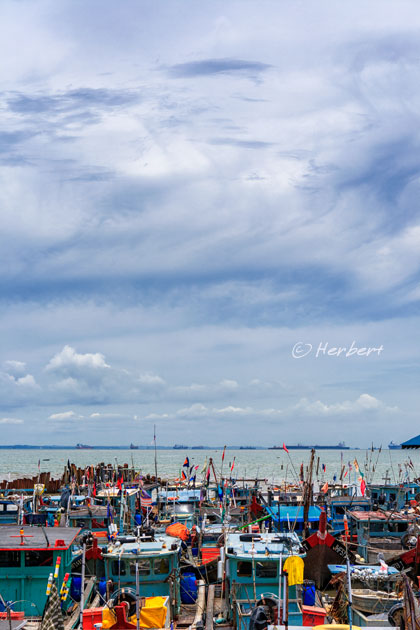
Location: Sungei Rengit, Johor, Malaysia (1° 21' 0 N, 104 ° 13' 0 E)
Date: 17 April 2008 10.20am
Camera: Canon 400D with Sigma 17-70/f2.8-4.5
Sungei Rengit is a small sleepy fishing town in the Pengerang district in the southeast corner of West Malaysia. It is popular with Singaporeans who come over in the weekends, either with their bicycles to cycle around the quaint countryside or in buses to pray at the various Chinese temples. Most of these weekend tourists will top off their visit with a sumptuous but cheap seafood meal in or around the town. However all of these are about to change with plan to build a RM5 billion (US$1.6 billion) independent deep-water petroleum terminal project and a regional oil storage hub due for completion in 2016. There are already various construction activities going on. Cyclists will soon have to cycle along highways, sharing them with tankers. Tourists coming over looking for “peace and quiet” quaint setting for their activities may bemoan the development and changes but the local population welcome such economic activities which bring employment and economic benefits to them. Ultimately that’s what’s more important rather than standing still as a playground for others.
June 21, 2012
How will the Euro crisis affects tourism in affected countries?
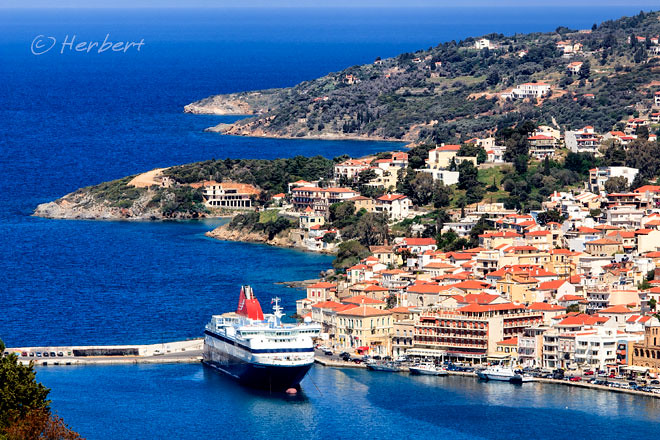
Location: Samos town on Samos Island, Greece (37° 44′ 0″ N, 26° 50′ 0″ E)
Date: 4 April 2010; 3.15pm
Camera: Canon 400D with Canon 70-200/f4L USM
The Euro crisis is throwing many people’s travel plans into a tailspin; at least those to and from some countries of Europe. The major concern for such travellers will likely to be how the exchange rates will be moving and how much as well as any implications in social order in some countries. In the case of Greece, the concern is not so much the Euro fluctuations but rather what would be the currency then and how chaotic things can be in that country. Interestingly friends in Europe’s critical-list countries such as Greece and Spain actually expects record tourist arrivals in the traditional high summer season. They reckon the current economic upheaval will encourage foreign tourists (which make up the bulk of their tourist trade) to visit the countries to take advantage of any potential price advantage on account of the weaker domestic demand or affordability.
June 18, 2012
Few travellers have been here before

Location: Yungbulakang Palace, Tibet, China (29° 8′ 38.76″ N, 91° 48′ 0.72″ E)
Date: 26 May 2005; 10.45am
Camera: Canon 300D with kit kens
China has been locking down Tibet, in an effort to prevent foreigners witnessing or accessing first-hand her iron-fisted policies on the Tibetan population. In 2011, Tibet was closed to foreign travellers for 3 months. This is happening again this year as more Tibetans are self-immolating as a protest against her repressive policies. It has been reported again that no independent foreign travellers are allowed into Tibet for the month of June. Only foreign travellers in a group of at least 5 from the same country are allowed to travel inside Tibet, and with a travel agent.
Personally I felt that this is counter-productive. Travellers generally, do not want to get involved in the country’s domestic affairs, apart from lending a sympathetic ear to complaints by Tibetans. Closing off the province simply give the impression that China has something to hide about its activities in Tibet from the world.
April 11, 2012
Will K2 be the same again the next time I am at Concordia?
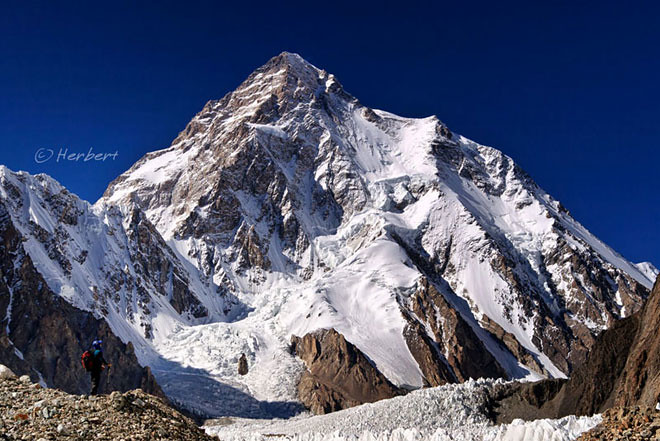
Location: K2 , Pakistan (35° 44′ 0″ N, 76° 31′ 0″ E)
Date: 10 July 2007; 7.30am
Camera: Canon 400D with Sigma 17-70/f2.8-4.5
I can boast with a little confidence that there are many places which I have been to that many people will only dreamed about. Predominantly I would list the high-attitude trekking to places such as Everest Base Camp, Concordia/K2 Base Camp, various places in Tibet and remote China and Ladakh/Kashmir. In fact I would love to go back to some of these places again for a couple of reasons:
(1) these places are no longer the same- most are more developed and lose their characters such as parts of (then) remote China, and permanent and irreversible changes to the landscape and environment wrought by climactic changes such as the Himalayas; and
(2) these places are so beautiful beyond descriptions and such a valuable experience that I like to bring the people that I loved, such as my wife and kid, to go enjoy them with me.
Hence, I made a promise to myself that I will trek to the Everest and Concordia Base Camps again, this time bringing my loved ones with me.
March 30, 2012
This used to be a church, before it became a mosque and then a museum

Location: Deësis mosaic, Hagia Sophia, Instanbul, Turkey (41° 0′ 31″ N, 28° 58′ 48″ E)
Date: 20 April 2010, 9.20am
Camera: Canon 400D with Sigma 17-70/f2.8-4.5
Hagia Sophia is a former church, then a mosque, and now a museum. As I have written before. to me it is comparable to the Vatican’s St Peter’s Basilica in its grandeur and place in history. One of the most exciting feature of the now-museum is the Deësis mosaic. It depicts Jesus as the ruler but what struck me is the tone of the mosaic and the humane and soft tone of the depictions. It is one of the strongest reminder to visitors that this building was a church.
Hagia Sophia is one of the must-see for any visitors to Turkey; hence it is always crowded with tourists, be it independent or the hordes that comes in tour groups. The best time to visit the building with a little peace and quiet is the earlier hours of the morning, when the tour groups hasn’t arrived yet.
March 20, 2012
This scene of Mount Semeru is probably gone forever

Location: Bromo-Tengger-Semeru National Park, East Java, Indonesia (7°59'7.19"S 112°59'9.64"E)
Date: 16 July 2008; 8.50am
Camera: Canon 400D with Sigma 17-70/f2.8-4.5
Bromo-Tengger-Semeru National Park is one of the most popular tourist destinations in Indonesia. It is popular for the casual tourists as well as those who are more adventurous. For the regular tourists, watching the sunrise over the volcanoes is the highlight; for the outdoor enthusiasts, trekking up Semeru and the breathtaking sunrise above the clouds at the summit of Semeru are most unforgettable. In fact one of the most unforgettable and rewarding experience of such a trek up Semeru has been the sense of adventure, proximity and feeling the power and danger of the regular eruptions of the volcano up-close. However since the violent eruptive activities of Semeru in late 2010/early 2011, which resulted in the ban on trekking up the volcano for a while, Semeru does not throw up any smoke and lava on a regular basis anymore. It is now just another volcano with (unimpressive) little plumes of smoke from its crater.
March 14, 2012
Happy smiling kids at Kashgar, Xinjiang, China

Location: Kashgar , Xinjiang, China (39° 45' 26 N 78° 24' 18 E)
Date: 2 October 2008; 10.30am
Camera: Canon 400D with Sigma 17-70/f2.8-4.5
I have not been to China for more than a year now. I used to travel to China a few times a year but lately I have been disgusted by the repressive reaction of the Chinese government towards the ethnic minorities in Xinjiang and Tibet- places that I enjoyed and loved. The major minorities of these 2 provinces, the Uighurs’ and Tibetans’ have been suffocating under the weight of Han migration, diluting their numbers in their homeland as well as the slow destruction of their culture and traditions- sometimes intentionally- in the name of national identity. In some cases, centuries-old heritage were destroyed in the name of development, in the hands of Han Chinese. Both these minorities had pleaded in vain for the Chinese government to listen to their grievances, but instead the government only lectures in return. Hence it is unsurprising that some section of these population felt that the only way to be heard is through non-violence or protest actions such as the Tibetan self-immolation. Instead of attempting to understand and seek to redress such concerns, the government replied with more crackdowns, including granting police right to detention in “black jails” without trial. This is really sad. I just hope that the happy smiles of Uighur and Tibetan children are not lost forever.
March 5, 2012
Ama Dablam- the beautiful and masculine mountain is everywhere

Location: Tashinga, Khumbu, Nepal (27°50'3.35"N 86°44'31.18"E)
Date: 11 April 2000; 2.45pm
Camera: Canon EOS 500N (analogue) on slides and scanned
The Khumbu region where Everest is located is packed full of snow-capped mountains- be it the highest summits in the world or well-known climbing peaks. However no other mountains has a more imposing presence in this region, at least all along the Everest Trek, than the mighty Ama Dablam. Standing at 6,812m it is not considered a high mountain, at least not around here, but it can be seen virtually everywhere along the trek. It is such a masculine mountain that it is unmistakable looking from any face. It is also one of my favourite mountain.
February 27, 2012
Hand-making popiah is a dying tradition
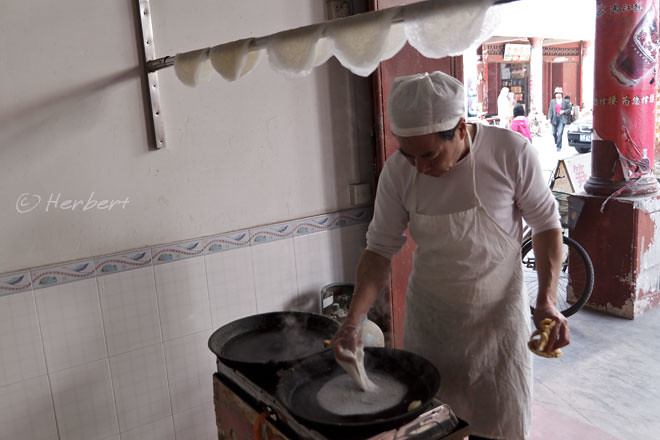
Location: Meizhou, Guangdong, China (24° 16′ 37.2″ N, 116° 6′ 57.6″ E)
Date: 22 December 2008; 10.50am
Camera: Canon 400D with Sigma 17-70/f2.8-4.5
A popular snack amongst the Fujian and Chaozhou dialect speakers in China, Taiwan, Singapore and Malaysia is a fresh spring roll known as popiah or literally thin cookie. A popiah is prepared by filling a thin paper-like pancake made from wheat flour with ingredients such as finely grated and steamed or stir-fried turnip, bean sprouts and any of the following: grated carrots, Chinese sausages, fried shallots, omelette and so on. The whole spring roll is normally eaten with sweet and chilli sauces.
These days popiah skins are produced by machines. However in most parts of China, they are still being made in the traditional way- a ball of wet and viscous wheat dough is held on one hand, which is quickly rubbed against a hot steel plate in circular motion and then lifted. This creates a very thin layer of the wet dough which adheres to the plate, cooked and then peeled off as popiah skin. A good popiah can only be made from a thin enough skin but so thin that it breaks under the weight of its fillings.
February 20, 2012
Locks for love and good wishes in temples of China

Location: Leshan, Sichuan, China (29° 32′ 50″ N, 103° 46′ 9″ E)
Date: 17 April 2003; 10.45am
Camera: Canon G1
In many places in China such as temples and on the steps/paths leading to sacred peaks, one can see love locks being attached to steel chains along trails, permanent barriers or on anything attachable. Couples announce their love for each other by engraving their names on the locks or write them on pieces of papers attached to the locks and then hang the locks and throw the keys away. It is hoped that their love will last as long as the ancient structures. This practice has now spread to other countries such as Japan, South Korea and South East Asia. In some places such as revered temples, one will also locks being hang onto places such as handles of typically giant-size incense burners like this in Leshan. Such locks are more likely for good luck wishes instead of love.
February 17, 2012
The ubiquitous black-and-yellow taxis of Mumbai & Delhi

Location: Mahim railway station, Mumbai, India (19° 2′ 6″ N, 72° 50′ 24″ E)
Date: 10 April 2007; 1040 am
Camera: Canon 400D with Sigma 17-70/f2.8-4.5
Most new visitors to India especially Mumbai and Delhi are surprised by the sights of the “classic Fiat” taxis. Surprise in that these cars are quite classic in nature as they are 1960’s models. However these models which are known as Premier Padmini still form the bulk of the axis that ploughs the streets of Mumbai and Delhi. They are distinctively painted with black and yellow liveries with the bottom half painted black and upper half painted yellow. Most of these taxis do not have air-conditioning and is quite an experience to ride in one in the summer. Furthermore the interior is rather small- those with longer legs will find them quite uncomfortable. Some of these taxis have air-conditioning installed but passengers will have to pay extra for having it turned on for a journey. An interesting feature of such taxis is that the meter is located outside the car on the passenger side; a passenger is expected to flick the lever down to engage the meter when he takes the taxi- see photo.
Another “classic car” (even older model) that one will see on the roads of India is the cream colour stately Hindustan Ambassador. The Ambassador is a more expensive class of taxis with bigger interior and is charged at a higher rate.
February 11, 2012
Same God looks different in different countries……..
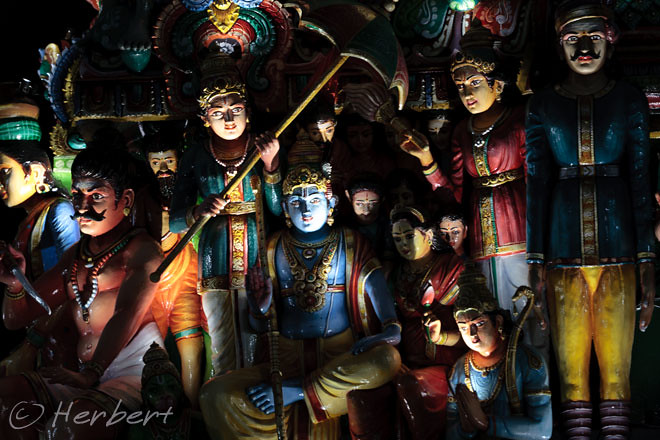
Location: Sri Mariamman Temple, Singapore (1°16′57.4″N 103°50′43″E)
Date: 12 October 2010; 7.50pm
Camera: Canon 400D with EOS L 70-200/f4
Same religions are practised all over the world. Perhaps with the exception of Islam, all religions has depictions of its own god(s) and deities. Most of these depictions are mainly either paintings or sculptures. It is very common for people in different countries, cultures and races to depict the gods in their own “image” so to speak. Hence Jesus looks Middle Eastern in most Western depictions while in Asia, He is a little more clean-shaven a-la Asian. Similarly Buddha is depicted with Oriental features in China, Japan, Korea and other East Asian cultures compared to the more natural (since He is after all, an Indian national) depiction in South Asian countries. Divine depictions not only varies between different countries and cultures, they are also influenced by the age or era of the depictions. Hence it is very common to see Buddha being depicted as a plump person in paintings and sculptures from China’s Tang Dynasty compared to the other ages. For that matter, Hindu gods and deities in countries such as Singapore also has slightly more “East Asian” features rather than Dravidian.
February 4, 2012
One cannot find another more amazing railway station than Chhatrapati Shivaji Terminus of Mumbai

Location: Chhatrapati Shivaji Terminus, Mumbai, India (18° 56′ 24″ N, 72° 50′ 7.08″ E)
Date: 2 October 2005; 11.30am
Camera: Canon IXUS iZoom
Train stations are some of the most beautiful and historical buildings in any country. This is especially true of former colonies; such stations are replete with histories of the nations concerned. Often they are fabulous buildings elaborately designed and built, reflected the style of the era. Examples include the Moorish Central Station in Kuala Lumpur and the fabulous Chhatrapati Shivaji Terminus (formerly known as the Victoria Terminus) of Mumbai. Less dramatic ones include the former Tanjung Pagar station of Singapore and the biggest railway station in the world, New York’s Grand Central. All of these railway stations are still standing and most of them are still serving their original function as a terminus where humanity meets and histories created.
February 1, 2012
Manarola- pretty any time of the day

Location: Manarola, Cinque Terre, Italy (44° 6' 0 N 9° 43' 60 E)
Date: 10 March 2005; 4.15pm
Camera: Canon 300D with kit lens
Cinque Terre is one of my favourite place in Italy. The 5 villages are replete with plenty of photo opportunities and the people are super-friendly. Furthermore it is a very pleasant walk between the villages especially for those who wanted some light walking rather than strenuous trek. Manarola is probably the most scenic of the villages with nice colourful houses and postcard-like harbour that is pretty in the daytime (as above) or at dusk or dawn and has been subject of many photographers. The other village that is attractive to me is Venazza. I hope the place is as enjoyable and unspoilt the next time I visit- unlike places in China.

















